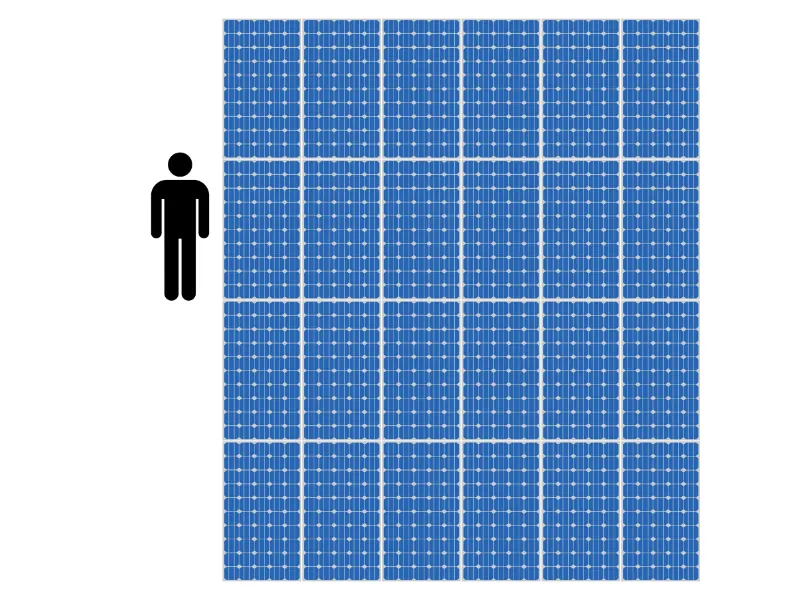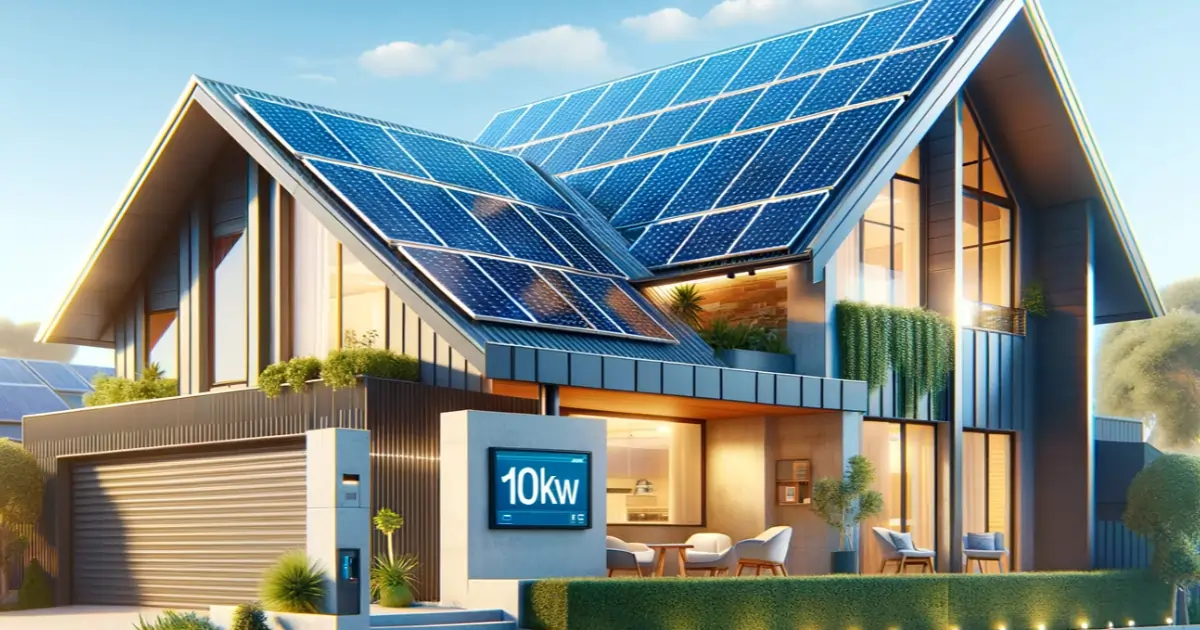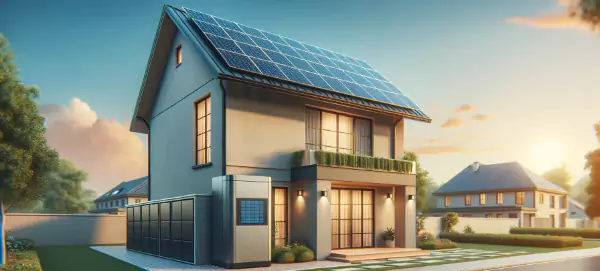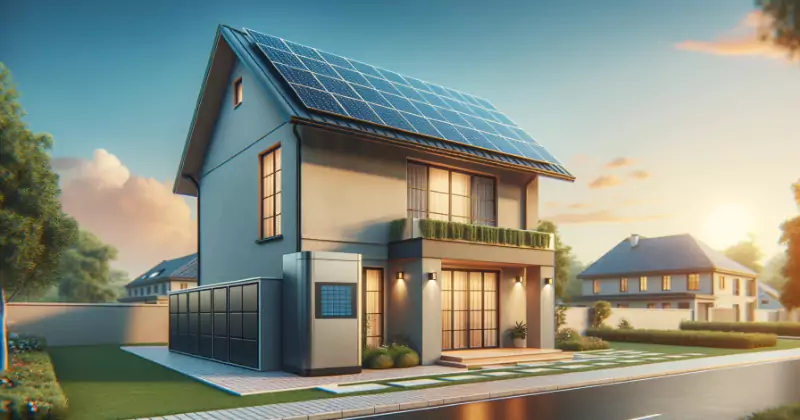A 10kW solar power system is an extensive capacity system for most Australian homes. Installation of such a system requires a significant area of roof space to accommodate the solar panels and entails substantial savings in electricity bills. Therefore, if you have a spacious roof area and want to reduce your electricity expenses, a 10kW solar power system might be the optimal solution for you.
A solar power system with a capacity of 10kW typically generates an average of 40kWh of electricity per day, capable of powering the appliances in a large 5+ bedroom household. Such appliances include lighting fixtures, televisions, laptops, refrigerators, washing machines, dryers, central air conditioning systems, and pool pumps.
Here's a breakdown of the wattage, average daily usage for each household appliance, and total watts consumed. All of these appliances can be powered by a 10kW solar system. This information will help you understand how much energy your household appliances consume and how much solar power you need to meet your energy needs.
| Appliance | Watts per hour | Avg hours used daily | Total watts |
|---|---|---|---|
| Lights for 5 bedroom home (10 x 7 watt LED lights [60W equivalent per globe]) | 70 | 6 | 420 |
| 2 LCD televisions | 60 | 5 | 300 |
| 2 Laptops | 200 | 6 | 1,200 |
| Microwave | 1500 | 0.3 | 450 |
| Dishwasher | 1800 | 1.5 | 2,700 |
| Freezer | 42 | 24 | 1,000 |
| Refrigerator | 35 | 24 | 900 |
| Central air conditioner | 3200 | 3 | 9,600 |
| Wifi | 6 | 24 | 144 |
| Pool pumps | 2000 | 8 | 16,000 |
| Washing machine | 500 | 0.5 | 250 |
| Clothes dryer | 4000 | 0.3 | 1,050 |
| Total | 34,000 |
How Much Power Does a 10kW Solar Power System Produce?
A 10kW solar power system can generate up to 40kWh of electricity daily to power two average-sized homes or a single large residence. In Australia, the average household consumes between 20kWh to 22kWh of electricity daily. As a result, a 10kW solar system is an excellent choice for a large household with several appliances or a small business.
If your home is connected to the grid, you can benefit from a feed-in tariff by selling any excess energy you generate during the day back to the grid and then using grid power at night. Installing an oversized solar system can decrease energy bills. The extra power generated during the day can offset the amount you draw from the grid at night.
How Much Roof Space Does a 10kW Solar Power System Require?
Continuing advancements in solar panel technology and efficiency mean that a 10kW system in 2023 is much more efficient and requires less roof space than the same-sized systems installed just a few years ago. For example, a 10kW system using 415W panels requires just 24 panels, which take up about 46 square meters of roof space. Such a system can generate approximately 40kWh of electricity daily, or around 14,600 kilowatt-hours annually.

Is a 10kW Solar Power System the Best Size for Me?
When choosing a solar system for your home, it's important to consider your current and future energy consumption. For example, if you plan to install an electric car charger at home, your electricity usage will likely increase. Similarly, suppose you have a large house with a pool and central air conditioning. In that case, you may consume significant power, making a 10kW solar system a suitable option. However, if your power needs are lower or you anticipate a decrease in usage, a 10kW system may be unnecessary.
To determine your home's appropriate solar system size, you can calculate your average daily energy usage. Take your last quarterly power bill, divide it by 3 to get your monthly use in kWhs, and then divide it by 30 days. If your average daily usage is around 35-40kWh, a 10kW system may be suitable. If it's closer to 20kWh, a 5kW system may be a better fit. You can maximise your energy savings by choosing the right solar system size.
Can You Go Off-Grid With a 10kW Solar Power System?
If you're wondering whether a 10kW solar power system can take you off-grid, yes! Suppose your daily electricity consumption is equal to or less than what the system produces. You have enough battery power to store 3 - 5 days' worth. In that case, you can break free from the grid.
However, consider a few key factors before you make the leap. Location is crucial – your home must receive enough sunshine to power your solar system effectively. Ensure your solar panels are placed in an open, sunny area free from shade.
To ensure optimal placement and get an accurate quote, invite a solar panel installer to inspect your home beforehand. They can evaluate your roof space and determine the best placement for your panels.
While the initial cost of battery storage can be expensive, rebates are available in some states like Queensland and South Australia. Alternatively, staying grid-tied with a battery backup that stores 70% of your daily usage and drawing from the grid during extended periods of rain can save you significant money in the long run. Remember that batteries typically come with a ten-year warranty and must be replaced eventually.
How Much Does a 10kW Solar Power System Cost?
The price of a 10kW solar power system can differ significantly based on the quality of the supplied components and the logistics of the installation itself. With the solar rebate factored in for 2023, the expected cost will be between $8,500 to $13,000, which covers expert installation from a reliable installer. Beware of solar systems that fall under the lower end of this price bracket since they might have substandard components that can lead to future problems. Put simply: inexpensive solar power systems can and probably will cost you more in the long run.
How Long Does It Take for a 10kW Solar Power System To Pay for Itself?
A 10kW solar power system can offer homeowners and businesses considerable savings on electricity bills. The savings depends on how much solar electricity is consumed internally compared to exported back to the grid. In large homes or businesses that consume all their solar electricity, savings of up to $4,500 can be achieved in the first year. However, most households will only use some of their solar energy because they're empty during the day; with everyone at work or school, the only appliance running is a refrigerator or freezer. Exporting half of the energy can save around $2,700 in the first year, and exporting all the energy could save approximately $1,000 in the first year.
Investing in a 10kW solar power system may seem expensive initially. Still, it can pay for itself in approximately 5 to 6 years. After that, the electricity generated is free, with minimal maintenance costs such as inspection every five years and an inverter replacement every 12-15 years. This makes solar power a wise long-term investment for those looking to save on their energy bills and reduce their carbon footprint.
Is The Solar Rebate Reducing?
The solar rebate gradually decreases by 1/15 annually until 2030, when it will be completely phased out. As a result, the cost of solar systems is also decreasing. The price of the 10kW solar system offered includes the rebate. To take advantage of higher rebate rates and quicker payback periods, purchasing your solar system now is advisable. Waiting will result in a lower rebate and a longer payback period.
Does the Location of Your Home Determine How Much Power You Produce?
Your home's location affects how much power your 10kW solar system generates. For instance, a 10kW solar system in Perth produces 44kWh, while the same system in Melbourne produces 36kWh. However, the expected power production of a 10kW solar system is 40kWh. The amount of electricity your solar system generates varies with location and season. Areas with more sunlight hours generally produce more electricity than colder regions. Conversely, the solar system produces less electricity during winter and on days with minimal sunlight.
If you're planning to buy a 10kW solar power system in 2023, it's essential to have sufficient roof space to install the solar panels. Moreover, it would be financially feasible only if your electricity bills are significantly high. If you own an electric vehicle or plan to purchase one, a solar power system could be a wise investment for you.
Understanding the Difference Between kW and kWh
kW (kilowatt) and kWh (kilowatt-hour) are both units of measurement used to describe the amount of electricity being used or generated.
A kilowatt (kW) is a unit of power, which is the rate at which energy is used or generated. One kilowatt is equal to 1,000 watts. For example, a device with a power rating of 2 kW uses 2,000 watts of power.
On the other hand, a kilowatt-hour (kWh) is a unit of energy, which is the amount of electricity that has been used or generated over a period of time. One kilowatt-hour is equal to 1,000 watt-hours. For example, if a device uses 2 kW of power for 1 hour, it will consume 2 kWh of energy.
In summary, kW measures the rate at which energy is used or generated. In contrast, kWh measures the total amount of energy used or generated over a period of time.


